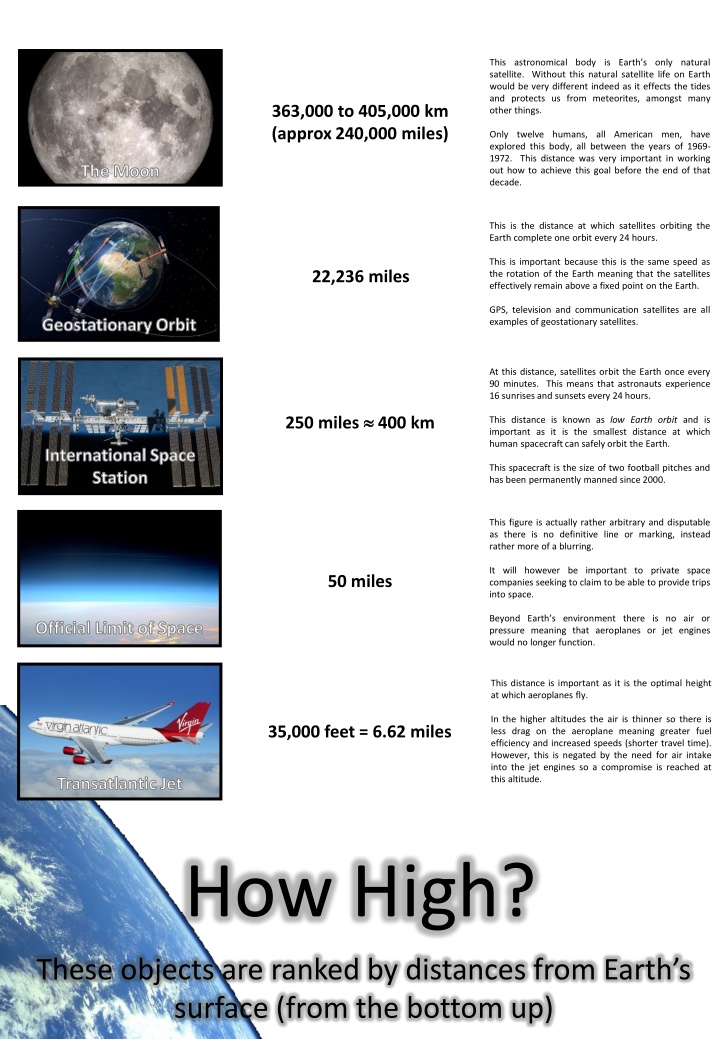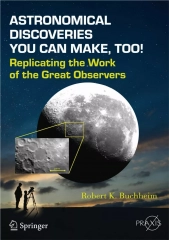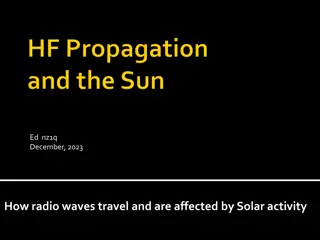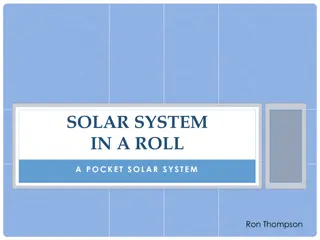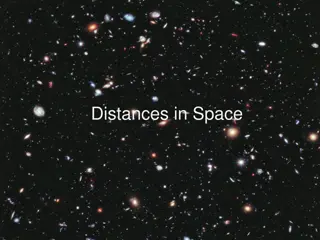Distances and Astronomical Bodies in Our Solar System and Beyond
Earth's natural satellite, the Moon, plays a crucial role in shaping life on our planet. Various distances in space, from geostationary orbit to Andromeda Galaxy, hold significance for understanding space exploration and cosmic phenomena.
Download Presentation

Please find below an Image/Link to download the presentation.
The content on the website is provided AS IS for your information and personal use only. It may not be sold, licensed, or shared on other websites without obtaining consent from the author.If you encounter any issues during the download, it is possible that the publisher has removed the file from their server.
You are allowed to download the files provided on this website for personal or commercial use, subject to the condition that they are used lawfully. All files are the property of their respective owners.
The content on the website is provided AS IS for your information and personal use only. It may not be sold, licensed, or shared on other websites without obtaining consent from the author.
E N D
Presentation Transcript
This astronomical body is Earths only natural satellite. Without this natural satellite life on Earth would be very different indeed as it effects the tides and protects us from meteorites, amongst many other things. 363,000 to 405,000 km (approx 240,000 miles) Only twelve humans, all American men, have explored this body, all between the years of 1969- 1972. This distance was very important in working out how to achieve this goal before the end of that decade. The Moon This is the distance at which satellites orbiting the Earth complete one orbit every 24 hours. This is important because this is the same speed as the rotation of the Earth meaning that the satellites effectively remain above a fixed point on the Earth. 22,236 miles GPS, television and communication satellites are all examples of geostationary satellites. Geostationary Orbit At this distance, satellites orbit the Earth once every 90 minutes. This means that astronauts experience 16 sunrises and sunsets every 24 hours. 250 miles 400 km This distance is known as low Earth orbit and is important as it is the smallest distance at which human spacecraft can safely orbit the Earth. International Space Station This spacecraft is the size of two football pitches and has been permanently manned since 2000. This figure is actually rather arbitrary and disputable as there is no definitive line or marking, instead rather more of a blurring. It will however be important to private space companies seeking to claim to be able to provide trips into space. 50 miles Beyond Earth s environment there is no air or pressure meaning that aeroplanes or jet engines would no longer function. Official Limit of Space This distance is important as it is the optimal height at which aeroplanes fly. In the higher altitudes the air is thinner so there is less drag on the aeroplane meaning greater fuel efficiency and increased speeds (shorter travel time). However, this is negated by the need for air intake into the jet engines so a compromise is reached at this altitude. 35,000 feet = 6.62 miles Transatlantic Jet How High? These objects are ranked by distances from Earth s surface (from the bottom up)
Of the 100 billion galaxies in the universe, this is the closest to us. 2,537,000 light years This distance is important because this galaxy is travelling towards our own and will one day collide with ours. 1 light year 5.879 1012 miles 1 light second 186,000 miles This galaxy is a spiral galaxy and contains around 1 trillion stars. Andromeda Galaxy Beyond the solar system, this is the nearest star to Earth. 4.367 light years This distance is important because it is the smallest distance that light from the stars has to travel to reach us. It is also the shortest time in which light has travelled from any star to reach us on Earth. 1 light year 5.879 1012 miles 1 light second 186,000 miles Alpha Centauri This spacecraft was launched in 2006 and performed a flyby of Pluto in 2015, being the first ever spacecraft to achieve this. 39.53 AU The spacecraft has since continued to travel beyond Pluto s orbit and to reach the Kuiper Belt in 2019. New Horizons Spacecraft This distance is important as it provides an effective size (radius) of our solar system. This is the distance to our Sun and is important as it enables us to work out much of the science of life here on Earth. 93,000,000 miles = 1AU This distance is a standard unit in astronomy and provides a guide to other distances relative to our Earth and Sun. AU = Astronomical Unit This distance was unknown until the 1761 Transit of Venus across the face of the Sun. Our Sun These distances are the closest and farthest between this planet and the Earth. The distance varies as the Earth orbits our Sun much faster than this planet, consequently they are sometimes closer together and sometimes further apart. 48,000,000 to 234,000,000 miles These distances are extremely important in planning any space mission to this planet, and will be particularly so for any manned mission. Mars This satellite enables scientists and astronomers to study and learn about our Sun. As a result of the satellite we now understand a lot more about how our Sun works and its effects on our Earth. 932,000 miles 1,500,000 km This distance is important at it is the position of one of four Lagrange points around the Earth and, for this particular point, at which the gravitational pull of the Sun matches the opposing gravitational pull of the Earth. SOHO Solar Observatory
This astronomical body is Earths only natural satellite. Without this natural satellite life on Earth would be very different indeed as it effects the tides and protects us from meteorites, amongst many other things. 363,000 to 405,000 km (approx 240,000 miles) Only twelve humans, all American men, have explored this body, all between the years of 1969- 1972. This distance was very important in working out how to achieve this goal before the end of that decade. The Moon This is the distance at which satellites orbiting the Earth complete one orbit every 24 hours. This is important because this is the same speed as the rotation of the Earth meaning that the satellites effectively remain above a fixed point on the Earth. 22,236 miles GPS, television and communication satellites are all examples of geostationary satellites. Geostationary Orbit At this distance, satellites orbit the Earth once every 90 minutes. This means that astronauts experience 16 sunrises and sunsets every 24 hours. 250 miles 400 km This distance is known as low Earth orbit and is important as it is the smallest distance at which human spacecraft can safely orbit the Earth. International Space Station This spacecraft is the size of two football pitches and has been permanently manned since 2000. This figure is actually rather arbitrary and disputable as there is no definitive line or marking, instead rather more of a blurring. It will however be important to private space companies seeking to claim to be able to provide trips into space. 50 miles Beyond Earth s environment there is no air or pressure meaning that aeroplanes or jet engines would no longer function. Official Limit of Space This distance is important as it is the optimal height at which aeroplanes fly. In the higher altitudes the air is thinner so there is less drag on the aeroplane meaning greater fuel efficiency and increased speeds (shorter travel time). However, this is negated by the need for air intake into the jet engines so a compromise is reached at this altitude. 35,000 feet = 6.62 miles Transatlantic Jet How High? These objects are ranked by distances from Earth s surface (from the bottom up)
Of the 100 billion galaxies in the universe, this is the closest to us. 2,537,000 light years This distance is important because this galaxy is travelling towards our own and will one day collide with ours. 1 light year 5.879 1012 miles 1 light second 186,000 miles This galaxy is a spiral galaxy and contains around 1 trillion stars. Andromeda Galaxy Beyond the solar system, this is the nearest star to Earth. 4.367 light years This distance is important because it is the smallest distance that light from the stars has to travel to reach us. It is also the shortest time in which light has travelled from any star to reach us on Earth. 1 light year 5.879 1012 miles 1 light second 186,000 miles Alpha Centauri This spacecraft was launched in 2006 and performed a flyby of Pluto in 2015, being the first ever spacecraft to achieve this. 39.53 AU The spacecraft has since continued to travel beyond Pluto s orbit and to reach the Kuiper Belt in 2019. New Horizons Spacecraft This distance is important as it provides an effective size (radius) of our solar system. This is the distance to our Sun and is important as it enables us to work out much of the science of life here on Earth. 93,000,000 miles = 1AU This distance is a standard unit in astronomy and provides a guide to other distances relative to our Earth and Sun. AU = Astronomical Unit This distance was unknown until the 1761 Transit of Venus across the face of the Sun. Our Sun These distances are the closest and farthest between this planet and the Earth. The distance varies as the Earth orbits our Sun much faster than this planet, consequently they are sometimes closer together and sometimes further apart. 48,000,000 to 234,000,000 miles These distances are extremely important in planning any space mission to this planet, and will be particularly so for any manned mission. Mars This satellite enables scientists and astronomers to study and learn about our Sun. As a result of the satellite we now understand a lot more about how our Sun works and its effects on our Earth. 932,000 miles 1,500,000 km This distance is important at it is the position of one of four Lagrange points around the Earth and, for this particular point, at which the gravitational pull of the Sun matches the opposing gravitational pull of the Earth. SOHO Solar Observatory
